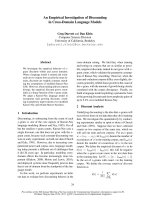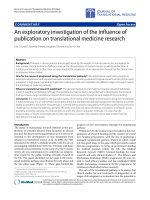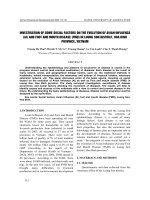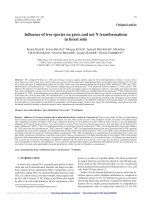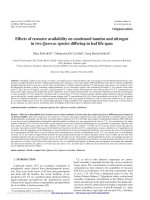An initial investigation of pest species on dai loan mango planting in cao lanh city, dong thap province, vietnam
Bạn đang xem bản rút gọn của tài liệu. Xem và tải ngay bản đầy đủ của tài liệu tại đây (1.19 MB, 9 trang )
Natural Sciences issue
AN INITIAL INVESTIGATION OF PEST SPECIES ON DAI LOAN
MANGO PLANTING IN CAO LANH CITY,
DONG THAP PROVINCE, VIETNAM
Nguyen Thi Oanh1* and Ha Danh Duc2
1
Center for Chemical Analysis, Dong Thap University
2
Department of Engineering and Information Technology, Dong Thap University
*
Corresponding author:
Article history
Received: 07/02/2020; Received in revised form: 21/02/2020; Accepted: 06/03/2020
Abstract
Insect pests that damage Dai Loan mango trees were preliminarily surveyed in some regions in Cao
Lanh city, Dong Thap Province, Vietnam. The results of the survey recorded twenty-nine species of insect
pests belonging to sixteen families, and five orders. Bactrocera dorsalis (fruit fly), Idioscopus nitidulus
(leafhopper) and Deanolis albizonalis (fruit borer) were very abundant, while Alcidodes frenatus had
the lowest numbers in all surveyed sites. A number of insect pest species that were observed attacking
mango in other places in Vietnam were not found in our surveys. However, fifteen species of insect pests
were noted in this study, but they have not been found in other places. The results reported here highlight
some insect pests attacking Dai Loan mango that have not been recorded before.
Keywords: Dai Loan mango, insect pests, species.
----------------------------------------------------------------------------------------------------------------------
DẪN LIỆU BAN ĐẦU VỀ THÀNH PHẦN LỒI CƠN TRÙNG GÂY HẠI
TRÊN XỒI ĐÀI LOAN TẠI THÀNH PHỐ CAO LÃNH,
TỈNH ĐỒNG THÁP, VIỆT NAM
Nguyễn Thị Oanh1* và Hà Danh Đức2
1
Trung tâm Phân tích Hóa học, Trường Đại học Đồng Tháp
2
Khoa Kỹ thuật - Công nghệ, Trường Đại học Đồng Tháp
*
Tác giả liên hệ:
Lịch sử bài báo
Ngày nhận: 07/02/2020; Ngày nhận chỉnh sửa: 21/02/2020; Ngày duyệt đăng: 06/03/2020
Tóm tắt
Bước đầu khảo sát về cơn trùng gây hại trên xoài Đài Loan đã được thực hiện tại một số xã thuộc
thành phố Cao Lãnh, tỉnh Đồng Tháp, Việt Nam. Kết quả đã ghi nhận có 29 lồi cơn trùng thuộc 16 họ
của 5 bộ. Các loài bắt gặp phổ biến gồm ruồi đục trái Bactrocera dorsalis, rầy bông xoài Idioscopus
nitidulus và sâu đục trái Deanolis albizonalis, trong khi lồi bọ đục cành Alcidodes frenatus có tần suất
bắt gặp ít (< 25%) trong tất cả các địa điểm được khảo sát. Một số lồi cơn trùng gây hại xồi được ghi
nhận ở những địa điểm khác ở Việt Nam đã được cơng bố nhưng khơng được tìm thấy trong nghiên cứu
của chúng tơi. Tuy nhiên, có 15 lồi cơn trùng gây hại đã được ghi nhận trong nghiên cứu này, nhưng
không gặp ở những nơi khác. Kết quả của chúng tơi đã xác định một số lồi cơn trùng gây hại trên xồi
Đài Loan nhưng chưa được cơng bố trước đây.
Từ khóa: Xồi Đài Loan, cơn trùng, thành phần loài.
68
Dong Thap University Journal of Science, Vol. 9, No. 5, 2020, 68-76
1. Introduce
The mango, Mangifera indica, is an
important subtropical fruit in many countries
in Asia, Africa and America. In Vietnam, most
mangoes are cultivated in the southern provinces.
So far, Dong Thap has had the largest area of
mango cultivation in the Mekong Delta with
more than 10,000 hectares. The annual yield is
over 90,000 tons with a value estimated at 1,500
billion VND (Vietnam Agriculture Newspaper,
2018). Cao Lanh city is a large mango producer
in Dong Thap Province with several genera: Cat
Chu, Cat Hoa Loc and Dai Loan. The genus Dai
Loan has been increasingly cultivated for recent
years because of its large fruits, thick flesh, thin
seeds and sweet flavor. It grows and develops
quickly, produces fruits throughout the year, and
adapts well to many soil types, including acidic
sulfate soil and mildly saline soil.
In recent years, however, mango has been
devastated by insect pests that reduced the
quantity and quality of the fruit, especially the
Dai Loan mango. Some studies on mango pests
have been carried out by Nguyen Thi Thu Cuc,
Nguyen Thi To Tran, Nguyen Hong Ung and
Vu Quang Giang in Viet Nam. Mango insect
pests were also described by Augustyn et al.,
Chowdhury, and Anant in other countries;
however, an investigation of the insect pests of
Dai Loan mango in Dong Thap Province has
not been conducted so far. Current studies have
mostly focused on insect pests of all mango
genera, but not a specific genus.
2. Materials and methods
2.1. Chemicals, materials and instruments
Ethanol (70%), ethyl acetate (> 99%), and
diethyl ether (> 99%) were purchased from
Sigma-Aldrich (USA) and used to store and
process insect samples. Insect net catchers
(Vietnam) and Townes-style Malaise traps
(Netherlands) were used to collect insects. A
digital camera (Sony DSC W-800 20.1 Mp) and a
stereo microscope Meiji Techno DK3000 (Japan)
equipped with a Lumenera INFINITY1-3C
camera (Canada) were used to take photographs
to identify and classify collected insect pests.
2.2. Methods of sample collection
Insect pest samples were collected from
gardens of Dai Loan mango trees in some
villages in Cao Lanh city: Tan Thuan Tay, Tan
Thuan Dong and Hoa An. The mango trees have
been planted for almost 10 years. Each garden
was more than 3,000 m2 in area. The collection
was conducted for one year, from November
2018 to November 2019, mainly by using
Townes-style Malaise traps. In addition, insect
samples were directly collected by hand and
using hand-net-catchers at four equidistant sites
near the edges and the center of each garden.
At each site, insect pests were also collected on
the branches of mango trees. All insect pests
were either immediately stored in 70% ethanol
(except butterflies and mealybugs), or treated
with ethyl acetate or diethyl ether. The collection
by all methods and investigation were conducted
every ten-day period. Obtained samples were
transported to the laboratory for analysis and
classification.
The abundance (C%) of an insect pest
species (A) was calculated by the following
equation:
C (%)
a
x 100.
b
In which, a is the number of sites where
species A was found, and b is the total number
of the investigated sites.
The obtained insect samples were observed
using a stereo microscope (Meiji Techno DK3000,
Japan) at 70X magnification. The measurement of
specimens and image processing were performed
using scale ruler software (Lumenera INFINITY1
- 3C, Canada). The classification of insect species
was based on the morphological characteristics
compared to the classification keys by Nugnes
et al. (2018), Kapoor (2005), Han et al. (2017),
69
Natural Sciences issue
Srinivasa et al. (2017), Alam et al. (2018) and
Pham Van Lam (2013).
3. Results and discussion
3.1. Insect species damaging Dai
Loan mango
Twenty-nine species of insect pests were
identified after the surveys in gardens of Dai
Loan mango in three places: Tan Thuan Tay,
Tan Thuan Dong and Hoa An. The insect pests
belonged to sixteen families, and fi ve orders:
Coleoptera, Diptera, Homoptera, Lepidoptera
and Thysanoptera. The types of insect pests
varied, depending on the plant parts being
attacked, e.g., stems, branches, leaves, flowers
and fruits (Table 1), (Figure 1).
Table 1. Species of insect pests damaging Dai Loan mango collected from three
communes in Cao Lanh city
Order
Coleoptera
Family
Attelabidae
Cerambycidae
Curculionidae
Diptera
Homoptera
Nitidulidae
Tephritidae
Cicadellidae
Coccidae
Coreidae
Diaspididae
Lepidoptera
Pseudococcidae
Crambidae
Erebidae
Noctuidae
Tortricidae
Thysanoptera Thripidae
Phloeothripidae
70
Species
Deporaus marginatus (Pascoe, 1883)
Plocaederus ruficornis (Newman)
Affected parts
Leaves
Trunk, branches
Leaf veins, young
Alcidodes frenatus Faust
branches
Hypocryphalus mangiferae (Stebbing, 1914) Tissues, bark
Seed cover, gemma
Sternochetus mangiferae (Fabricius)
Bark
Carpophilus spp.
Fruit
Bactrocera cucurbitae Coquillett
Fruit
Bactrocera dorsalis (Hendel)
Flowers, leaves
Idioscopus nitidulus (Walker)
Trunk
Ceroplastes ceriferus (Fabricius)
Trunk, leaves
Ceroplastes floridensis Comstock, 1881
Leaves, fruit
Vinsonia stellifera (Westwood)
Leaves, fruit
Cletus trigonus (Thunberg)
Leaves
Aspidiotus destructor Signoret
Leaves
Aonidiella aurantii Maskell
Leaves, fruit
Aulacaspis tubercularis Newstead
Bark, leaves fruit
Lepidosaphes beckii (Newman)
Leaves
Pseudaulacaspis cockerelli (Cooley)
Young leaves, fruit
Planococcus citri (Risso)
Fruit
Deanolis albizonalis (Hampson, 1903)
Leaves, flowers
Euproctis fraterna Moore
Leaves, flowers
Orgyia postica Walker
Flowers
Orvasca subnotata Walker
Shoot, flowers
Chlumetia transversa Walker
Young leaves
Cryptoblabes gnidiella (Milliere, 1867)
Leaf veins, young-left
Dudua aprobola (Meyrick)
stems, shoots
Fruit
Cydia sp.
Young leaves, flowers
Scirtothrips dorsalis Hood, 1919
Leaves, flowers
Haplothrips leucanthemi (Schrank)
Dong Thap University Journal of Science, Vol. 9, No. 5, 2020, 68-76
In a 2001 report, Nguyen Thi Thu Cuc
proposed methods for preventing damage
by twenty-two species of insect pests in the
Mekong Delta. The prevalent species in the
list included fruit flies, mealybugs, young stem
borers, bugs, and thrips. Nine species that were
recorded in the study conducted by Nguyen Thi
Thu Cuc (2001) were also observed in our study:
Deporaus marginatus, Plocaederus ruficornis,
Bactrocera cucurbitae, Bactrocera dorsalis,
Idioscopus nitidulus, Deanolis albizonalis,
Chlumetia transversa, Dudua aprobola and
Scirtothrips dorsalis.
Another study carried out in Binh Dinh
Province found 54 species belonging to 28
families, and 9 orders living on mango trees
(Nguyen Thi To Tran, 2002). Fruit flies, Bactrocera
dorsalis, leafhoppers, Idioscopus clypealis, and
shoot borers, Chulumetia transversa, were the
major pests identified in the study (Nguyen Thi
To Tran, 2002). However, only four species
found in Binh Dinh Province were also found
in the study in Dong Thap Province, namely
Sternochetus mangiferae, Bactrocera dorsalis,
Chlumetia transversa and Scirtothrips dorsalis.
Quach Thi Ngo et al. (2009) summarized the
pests damaging mangoes in Viet Nam with a
total of 79 species, of which seven species were
identified in our survey: Bactrocera dorsalis,
Idioscopus nitidulus, Pseudaulacaspis cockerelli,
Planococcus citri, Orgyia postica, Orvasca
subnotata and Scirtothrips dorsalis.
From these results, a number of insect pest
species damaging mangoes recorded in other
places were not found in our surveys. Fifteen
species of insect pest were observed in this study,
however, they have not been found in other places
in the Mekong Delta. In Malaysian countries,
surveys of mango pests have reported 29 species
belonging to 15 families observed during the
non-fruiting season, and 69 species belonging to
39 families observed during the fruiting season
(Abdullah and Shamsulaman, 2008). The number
of species in these surveys was higher than in our
study because they were conducted in a larger
area. In another report, Prakash (2012) found
22 species of insect pests on mango plantations
in West Bengal, India. Sahoo and Jha (2008)
(cited in Anant, 2016) observed 26 insect pests in
mango gardens such as fruit borers, leafhoppers,
hairy caterpillars, nest forming caterpillars, slug
caterpillars, shoot borers, bagworms, painted
bugs, aphids, mealy bugs, leaf-eating weevils,
grey weevils, fruit flies and gall insects. These
insect pests caused damage to mangoes during
flowering and fruit development. The occurrence
of pests during new flush, twig expansion, matured
leaf and fruit maturity stages of 0 to 5 year-old, 5
to 15 year-old and over 15 year-old mango trees
was determined in a field experiment conducted in
Andhra Pradesh, India (Kannan and Rao, 2006).
Some species reported at other investigated
sites were also found in this study. For example,
Deporaus marginatus (leaf-cutting weevil),
Sternochetus mangiferae (stone weevil),
Bactrocera dorsalis (fruit fly), Idioscopus
nitidulus (leafhopper), Aspidiotus destructor
(mango scale), Orgyia postica (leaf-eating
caterpillar), Chlumetia transversa (shoot borer),
Scirtothrips dorsalis (thrips) were observed
in India and also found in this study (Anant,
2016). Another study by Kannan and Rao
(2006) documented the incidence of different
pests related to different age groups of mango
trees. The authors found that from 0 to 5 years
old, the trees mainly encountered leaf-cutting
and leaf-eating insects, and stem borers such as
Rhynchaenus mangiferae Marshall, Apodercus
transquebaricus Fabricius, Deporaus marginatus
Pascoe, Penicillaria jocostarix Gune and Orgyia
postica Walker. After the trees were 5 to 15
years old, the most common pests were mainly
aphids such as Toxoptera odinae Vandergoot
and flower-feeding insects like Alassodes
quadraria Guen. Leaf spot-forming species
such as Procontarinia matteiana Kieffer and
Amradiplosis ecinogalliperda Mani were harmful
to plants older than five years.
71
Natural Sciences issue
1 - Deporaus marginatus
2 - Plocaederus ruficornis
3 - Sternochetus mangiferae
5a - Bactrocera cucurbitae (Male)
6a - Bactrocera dorsalis
(Male)
72
4 - Hypocryphalus mangiferae
5b - Bactrocera cucurbitae (Female)
6b - Bactrocera dorsalis
(Female)
7 - Ceroplastes ceriferus
Dong Thap University Journal of Science, Vol. 9, No. 5, 2020, 68-76
8 - Idioscopus nitidulus
11 - Aspidiotus destructor
14 - Deanolis albizonalis
17 - Orvasca subnotata
9 - Vinsonia stellifera
12 - Aulacaspis tubercularis
15 - Euproctis fraterna
18 - Chlumetia
transversa
10 - Deanolis albizonalis
13 - Lepidosaphes beckii
16 - Orgyia postica
19 - Scirtothrips dorsalis
73
Natural Sciences issue
20 - Haplothrips leucanthemi
21- Cydia sp.
Figure 1. Some insect pests harmful to the Dai Loan mango recorded during the surveying time
3.2. Abundance of insect pests on Dai
Loan mango
The species numbers at each survey site
were almost the same; however, the individual
abundance of each species was different (Table
2). Among them, Homoptera was the most
dominant order with eleven species belonging
to Cicadellidae, Coccidae, Coreidae, Diaspididae
and Pseudococcidae, while Alcidodes frenatus
was only found in Tan Thuan Tay.
Table 2. Abundance of insect pest species of Dai Loan mango in some communes
in Cao Lanh city
Abundance in surveyed sites
No.
Species
Tan Thuan
Tay
Tan Thuan
Dong
Hoa An
1
Deporaus marginatus (Pascoe, 1883)
++
+++
+++
2
Plocaederus ruficornis (Newman)
++
+++
+++
3
Alcidodes frenatus Faust
+
-
-
4
Hypocryphalus mangiferae (Stebbing, 1914)
++
++
++
5
Sternochetus mangiferae (Fabricius)
-
+
++
6
Carpophilus spp.
++
+
++
7
Bactrocera cucurbitae Coquillett
++
++
++
8
Bactrocera dorsalis (Hendel)
+++
+++
+++
9
Idioscopus nitidulus (Walker)
+++
+++
+++
10
Ceroplastes ceriferus (Fabricius)
+
+
++
11
Ceroplastes floridensis Comstock, 1881
+
-
+
12
Vinsonia stellifera (Westwood)
+
+
++
13
Cletus trigonus (Thunberg)
+
-
+
14
Aspidiotus destructor Signoret
+
+++
++
15
Aonidiella aurantii Maskell
+
+
+
16
Aulacaspis tubercularis Newstead
+
-
+
17
Lepidosaphes beckii (Newman)
++
+
++
74
Dong Thap University Journal of Science, Vol. 9, No. 5, 2020, 68-76
18
Pseudaulacaspis cockerelli (Cooley)
+
+
+
19
Planococcus citri (Risso)
++
++
+++
20
Deanolis albizonalis (Hampson, 1903)
+++
+++
+++
21
Euproctis fraterna Moore
++
++
++
22
Orgyia postica Walker
+
++
++
23
Orvasca subnotata Walker
+
+
+
24
Chlumetia transversa Walker
+
+
+
25
Cryptoblabes gnidiella (Milliere, 1867)
+
++
+
26
Dudua aprobola (Meyrick)
+++
++
++
27
Cydia sp.
++
++
++
28
Scirtothrips dorsalis Hood, 1919
++
++
++
29
Haplothrips leucanthemi (Schrank)
++
++
+++
Note: (-): not found; (+): not abundant (< 25%); (++): quite abundant (25 - 50%); (+++): very
abundant (>50%).
Table 2 also shows that, 28 species of insect
pests were recorded in Tan Thuan Tay commune,
of which four species appeared at more than 50%
abundance (Bactrocera dorsalis, Idioscopus
nitidulus, Deanolis albizonalis and Dudua
aprobola). Twenty-five insect pests were found
in Tan Thuan Dong with six species being very
abundant (Deporaus marginatus, Plocaederus
ruficornis, Bactrocera dorsalis, Idioscopus
nitidulus, Aspidiotus destructor and Deanolis
albizonalis). Twenty-eight species of insect
pests were recorded in Hoa An commune, of
which seven species appeared at more than 50%
abundance (Deporaus marginatus, Plocaederus
ruficornis, Bactrocera dorsalis, Idioscopus
nitidulus, Planococcus citri, Deanolis albizonalis
và Haplothrips leucanthemi).
Some species were found in one site but
did not appear in the other sites probably due to
differences in farming methods. Moreover, the
appearance of some insect pest species depended
on the trees’ developmental stage and which parts
of the mango trees were affected. For example,
aphids were mainly harmful at the time of
flowering and on young leaves, while fruit flies
did most damage at the time of fruit formation
and harvest.
4. Conclusion
Twenty-nine species of insect pests were
recorded in our surveys in Dai Loan mango
gardens in Cao Lanh City, Dong Thap Province.
The order Homoptera had the highest species
number with eleven, followed by Lepidoptera of
eight species, while Diptera and Thysanoptera
had only two species. Our survey results
recorded more than fifteen species in the
Mekong Delta.
Acknowledgements: This research is
supported by the project SPD2019.01.17./.
References
Abdullah F. and Shamsulaman K. (2008).
Insect Pests of Mangifera indica Plantation
in Chuping, Perlis, Malaysia. Journal of
Entomology, 5(4), 239-251.
Alam M. S., Rahman M. A., Jahan S. M. H.
(2018). Two new records of the Genus
Idioscopus Baker (Hemiptera: Idiocerinae)
from Bangladesh. International Journal of
Innovative Research, 3(1), 13-18.
Anant A. K. (2016). Studies on insect-pests of
mango with special reference to seasonal
incidence and management of mango leaf
75
Natural Sciences issue
hoppers. Master of Science in Entomology,
90 pages.
tỉnh Trà Vinh. Kỷ yếu Hội nghị Bảo vệ thực
vật, 429-435.
Augustyn W. A., du Plooy W., Botha B. M.
and van Wilpe E. (2013). Infestation of
Mangifera indica by the Mango Gall
Fly, Procontarinia matteiana, (Kieffer &
Cecconi) (Diptera: Cecidomyiidae). African
Entomology, 21(1), 79-88.
Nguyễn Thị Thu Cúc. (2001). Biện pháp phịng
trị cơn trùng và nhện gây hại trên cấy ăn
trái (xồi). NXB Đại học Cần Thơ.
Báo Nơng nghiệp Việt Nam. (2018). Xoài Đồng
Tháp vươn xa, />xoai-dong-thap-vuon-xa-post219139.html,
accessed: 25-05-2018.
Chowdhury S. K. (2015). Diversity and nature of
damage of mango insect pests at KaliachakII Block of Malda, West Bengal, India.
Journal of Entomology and Zoology Studies,
3(4), 307-311.
Han H. Y., Choi D. S., Ro K. E. (2017). Taxonomy
of Korean Bactrocera (Diptera: Tephritidae:
Dacinae) with review of their biology.
Journal of Asia-Pacific Entomology, 20(4),
1321-1332.
Kannan M. and Rao N. V. (2006). Influence of
age and stage of the host plant on insect
pests of mango (Mangifera indica L.).
International Journal of Agriculture Science,
2(2), 351-353.
Kapoor V. C. (2005). Taxonomy and Biology of
Economically Important Fruit Flies of India.
Israel Journal of Entomology, 35-36(6),
459-475.
Nguyễn Hồng Ửng, Lâm Quốc Nam, Pham
Thị Đông, Nguyễn Hồng Nương, Nguyễn
Thị Hồng Thủy. (2015). Một số đặc điểm
hình thái, đặc điểm sinh học cơ bản của rệp
sáp Aulacaspis tubercularis (Diaspididae,
Homoptera) trên xoài tại huyện Càng Long,
76
Nguyễn Thị Tố Trân. (2002). Điều tra nghiên
cứu sâu bệnh hại xồi tại Bình Định. Luận
án tiến sĩ nông nghiệp, Viện Khoa học Kỹ
thuật Việt Nam.
Nugnes F., Russo E., Viggiani G. and Bernardo U.
(2018). First Record of an Invasive Fruit Fly
Belonging to Bactrocera dorsalis Complex
(Diptera: Tephritidae) in Europe. Insects
2018 Dec., 9(4), 182 pages. doi:10.3390/
insects9040182.
Prakash O. (2012). National Horticulture Mission
Ministry of Agriculture Department of
Agriculture & Cooperation Krishi Bhawan.
New Delhi-110001, 46 pages.
Phạm Văn Lầm. (2013). Các loài côn trùng và
nhện nhỏ gây hại cây trồng phát hiện ở Việt
Nam. NXB Nông nghiệp.
Quách Thị Ngọ, Phạm Văn Lầm, Lê Thị Tuyết
Nhung, Trương Thị Hương Lan, Thế Trường
Thành. (2009). Kết quả điều tra thành phần
côn trùng và nhện hại xoài tại Việt Nam. Hội
nghị khoa học toàn quốc về Sinh thái và Tài
nguyên sinh vật lần thứ ba. NXB Khoa học
tự nhiên và Công nghệ: Hà Nội, 680-685.
Srinivasa N., Ramya N. and Meshram N. M.
(2017). Taxonomic studies of leafhoppers
(Hemiptera: Cicadellidae) fauna associated
with mango from India. International
Journal of Current Microbiology and
Applied Sciences, 6(10), 2108-2124.
Vũ Quang Giảng. (2017). Nghiên cứu biện pháp
phịng trừ sâu đục quả xồi tỉnh Sơn La. Đề
tài Khoa học và Công nghệ tỉnh Sơn La.


